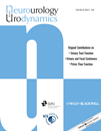Central inhibitory effect of intravesically applied botulinum toxin A in chronic spinal cord injury†
Conflict of interest: none.
Abstract
Aims
We evaluated a putative central inhibitory effect of intravesical botulinum toxin A (BoNT-A) on the activity of lumbosacral spinal neurons in a chronic spinal cord injury (SCI) model of bladder overactivity.
Methods
Female Sprague-Dawley rats underwent T8 spinal cord transection. Four weeks later, once overactive neuropathic detrusor pathways had developed, the animals underwent intravesical instillation with either saline (1 ml) or BoNT-A (Botox®, 20 U/1 ml) for 1 hr. Two days later, the rats then completed a cystometric evaluation prior to spinal cord harvest. Sections from the L4-S1 spinal cord segments were examined for the total number of c-fos immunoreactive cells.
Results
Comparison of the saline and BoNT-A treated groups showed a significant decrease in L6 (i.e., 67%, P < 0.001) and S1 (i.e., 47%, P < 0.01) c-fos expression (43%) in BoNT-A treated rats compared to saline controls. Cystometrogram studies revealed that the frequency of non-voiding bladder contractions was reduced by 73% (P < 0.05) in BoNT-A compared to saline treated rats. No change in the frequency of voiding bladder contractions or amplitude of bladder contraction was observed between the saline and BoNT-A treated groups.
Conclusion
In a SCI model of bladder overactivity, intravesical BoNT-A significantly inhibits the response of bladder afferent activated lumbosacral neurons without significantly impairing efferent bladder function. Neurourol. Urodynam. 30:1376–1381, 2011. © 2011 Wiley-Liss, Inc.




